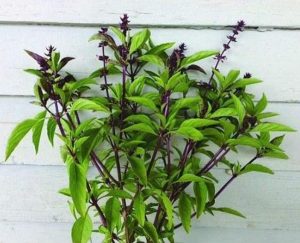 Scientific name: Ocimum basilicum
Scientific name: Ocimum basilicum
Usage:
Thai basil is widely used in the cuisines of Southeast Asia, including Thai, Vietnamese, Laotian, and Cambodian cuisines. Thai basil leaves are a frequent ingredient in Thai green and red curries, though in Thailand the basil used in drunken noodles and many chicken, pork, and seafood dishes is holy basil.
Thai basil uses include infusing with vinegar or oil, flavouring Pho with mint and chilies, making tea, or being paired with almost any chicken, pork, or beef dish.
Thai basil may also be used as an aromatherapy treatment by bruising the leaves and inhaling their aroma. They can be bruised and rubbed beneath the eyes and on the forehead for a relaxing reprieve from a long stressful day (Grant B. L., Thai Basil Plants: Tips For Growing Thai Basil Herbs, 2019).
Country of Origin
Thai basil is native to Southeast Asia and is believed to have originated in Thailand. Generally, any purple stemmed basil with a liquorice flavour is considered to be “Thai basil”. There are a few recognised varieties, such as Queenette and Siam Queen. (Produce, 2019)
Time to harvest
Whether you direct-sow basil or start the seed indoors about 6 weeks before the last expected spring frost, it can take 50 to 75 days before the basil is harvest-ready. The plant’s appearance can indicate when you can harvest. The basil’s flavour and aroma are at their peak upon having developed 6 pairs of leaves on a branch. This is right around the time when the plant starts to set flower buds. This is the best time to harvest because flowering can negatively affect the flavour of the leaves (Produce, 2019).
Share with:

